SEE MORE: What the ETF Industry Has Done Since the Mini Flash Crash
Consequently, ETFs experienced some of the most severe price declines as market makers struggled to price derivatives due to uncertainty over tradability and pricing of hedges. Many ETFs that typically traded in line with their net asset value were negatively affected as trades on some of their underlying stock holdings were halted – the ETFs’ prices showed large divergences to their NAV.
In an attempt to keep market makers where they are needed the most, BATS plans to provide market makers payments on a sliding scale. Those who trade more than 35 million ETF shares on average per year will receive $400,000. However, none of the exchanges 98 ETFs currently fit this top level. Currently, some funds trade five to 10 million shares per day, which could be worth $50,000 per year to market makers, according to Harkin.
The incentives should ultimately help investors execute more efficient trades.
“The whole goal is that if you come up with incentives that make it more attractive to be a market marker, they can more effectively do their jobs not just in liquid products but across the suite,” Harkins told the Financial Times. “We are hoping they pour that back into newer and less liquid products.”
For more information on the ETF industry, visit our current affairs category.
